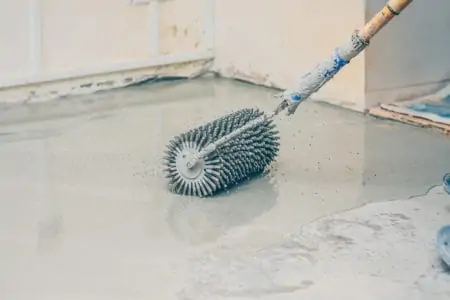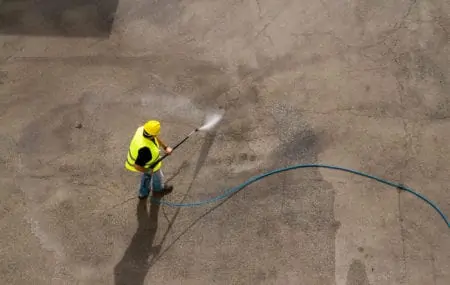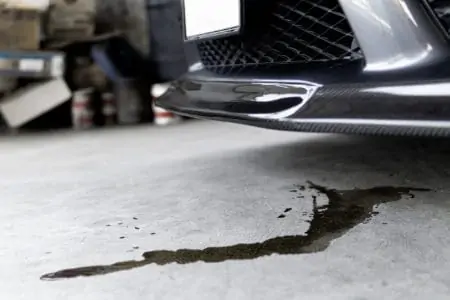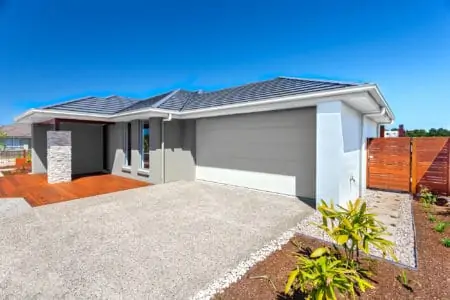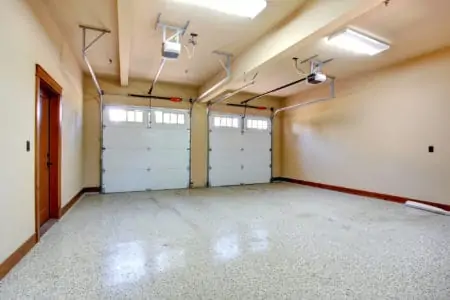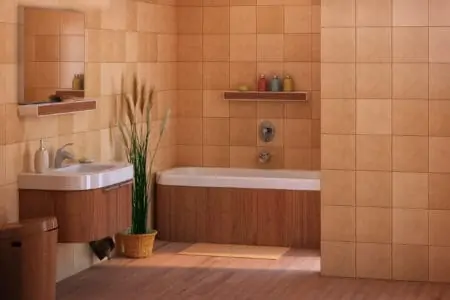Flooring in high-traffic settings gets a lot of punishment, and finding a material that can withstand such abuse is tricky. However, epoxy floor coatings are a stand-out option because they are durable, customizable, and decorative.
We tell you everything you need to know about epoxy flooring, including the main advantages and disadvantages.
Key Takeaways
- Epoxy flooring is a durable and customizable option for high-traffic areas.
- There are various types of epoxy flooring, including self-leveling, quartz-filled, epoxy mortar, anti-static, and epoxy flake.
- Advantages of epoxy flooring include chemical resistance, impact resistance, long-lasting, strong, and decorative.
- Disadvantages of epoxy flooring include toxic fumes, long setting time, requiring a subfloor, and potential slipperiness when wet.
What Is Epoxy Flooring?
Epoxy is a resinous covering that consists of a two-part system using polymer resins and a hardener. The resin and hardener bond with each other and the floor to form a hard seal that withstands almost anything.
Epoxy flooring consists of multiple layers of resin applied to a depth of at least two millimeters. Epoxy is useful in so many ways, from woodworking and making skateboards to circuit boards and the aircraft industry. Epoxy garage floor paint is also used as protection for concrete floors.
The Difference Between Epoxy Paint, Flooring, and Coating
Epoxy paint is a latex-based product treated with epoxy to form a hard shell on your garage or workshop floor. It differs from standard floor paint because it adheres better and is more durable.
Epoxy flooring is different from epoxy floor paint, sometimes referred to as epoxy coating, because it requires a chemical reaction to set.
It is a two-part system that involves combining resin with hardener to create a hard shell. The other distinct variation is epoxy flooring has to be a minimum of two millimeters thick.
Epoxy floor coatings and paint don’t have minimum depth requirements and are typically less than two millimeters.
Types of Epoxy Flooring
Epoxy comes in many versions, each with unique uses. The type of epoxy flooring you choose depends on where you intend to apply it. Do you want decorative value or strength, or does it need to be suitable for exterior concrete?
Let’s explore the different types of epoxy and where they are most commonly used.
Self-Leveling
If you have cracked, old, or uneven concrete, a self-leveling epoxy is the best product to use. It creates a smooth surface that dries to a glass-like finish. It is durable, water-resistant, chemical-resistant, and comes in a wide range of colors.
Self-leveling epoxy flooring is typically used in commercial warehouses, factories, showrooms, commercial garages, and some athletic facilities.
Quartz-Filled
Quartz-filled epoxy flooring is a combination of polymer resin and quartz grains. It is highly decorative and works well in spaces that require sanitary flooring with anti-slip qualities.
You will likely see quartz flooring in locker rooms, showrooms, cafeterias, hotel lobbies, restrooms, and schools.
Epoxy Mortar
Epoxy mortar floors are the most robust of all the flooring types. It consists of 100 percent solid epoxy and quartz sand. Aside from the fact it is chemically resistant and perfect for high-impact locations, it is also useful for making repairs to cement crack.
Thanks to its strength, this flooring is perfect for basement floors, commercial garages, industrial buildings and warehouses, commercial kitchens, and mechanical spaces.
Anti-Static
Electro-static charge (ESD) can be dangerous in some work environments, especially in places where flammable material and chemicals are stored and used.
Anti-static epoxy flooring (sometimes called ESD resistant flooring) contains conductive compounds that absorb electrical charge, allowing it to dissipate.
Environments using this type of flooring include electronic, chemical, and medical facilities, where flammable gas or volatile liquids are used.
Epoxy Flake
Epoxy flake floors are highly decorative, making them a favorite with clinics, sports facilities, showrooms, locker rooms, and commercial kitchens. They contain colored flakes of material that give the floor a multi-layered and seamless look.
They also have anti-slip qualities because the flakes create slight grooves that increase grip.
Are Epoxy Floors Worth It?
Epoxy is not a cheap alternative to other types of flooring, so it begs the question, “is it worth it?” Everything has pros and cons, but do the advantages outweigh the disadvantages or vice versa?
Advantages of Epoxy
Epoxy has many qualities useful in commercial and domestic settings. It is decorative, hard-wearing, and offers protection against UV rays and moisture. Let’s look at a few more advantages:
Chemical Resistance
Garages are full of chemicals like petroleum, paint, solvents, and oil, so having a chemically resistant floor protects your concrete. It wipes clean and doesn’t stain the floor, making it ideal for commercial settings like paint shops and pharmaceutical facilities.
Impact Resistance
Epoxy is the Rocky Balboa of flooring; it soaks up punishment and still looks good. It resists impacts from heavy loads, making it suitable for spaces like garages or mechanical settings with industrial-grade machinery.
It also resists heat and water, so sealing your patio against UV and rain protects outside surfaces.
Long-Lasting
When you go to the trouble and expense of laying an epoxy floor, you want it to last the distance. Given that most epoxy floors face a tough time, it is even more crucial that they soak up the punishment and retain their good looks.
FYI
Most epoxy manufacturers guarantee their products for 10 years, but that depends on whether you have installed it correctly.
Strong
If you want flooring that withstands the pressure of heavy machinery, choose epoxy. It dries to an almost indestructible shell, making it ideal for industrial buildings and factories.
Epoxy flooring also increases stability, giving you a steady base for heavy machinery like hydraulic ramps and warehouse shelving.
Protection
One of the core advantages of epoxy is it protects the surface beneath. If you have old concrete, epoxy blocks the damaging effects of rainwater and UV, especially in outdoor spaces.
Good To Know
You can also buy food-grade epoxy to protect kitchen countertops and dining tables.
Decorative
Whatever style you are aiming for, epoxy flooring has an additive to suit. You can go for reflective surfaces, flakes of sparkly quartz, or several different colors. And because epoxy can be used almost anywhere, it transforms tables, countertops, garage floors, and patios.
Covers Damage
Older concrete surfaces show their scars, but epoxy covers uneven, cracked, and discolored surfaces. In addition, combining the decorative elements will transform your tired flooring, making it unrecognizable.
Easy to Lay
Besides vigorous cleaning to remove stains and to fill any cracks, epoxy doesn’t require any extensive or additional subfloor preparation. Simply pour it with a hardener and wait for it to set. Most epoxies are self-leveling, so you don’t even need to smooth the surface.
Safety
Epoxy is smooth, seamless, and dries to an impenetrable shell that can take the weight of most industrial machinery. It is easy to keep clean and resists wear and tear. It makes epoxy a safe product to use in commercial settings like showrooms, garages, and manufacturing facilities.
Disadvantages of Epoxy
Okay, so it’s not all wine and roses when it comes to epoxy flooring. There are disadvantages you should consider before committing to laying an epoxy floor.
Toxic Fumes
Epoxy gives off an ammonia-like smell, irritating eyes, nose, and throats, especially when used inside. You need to wear a face mask and safety goggles to reduce instances of inhalation.
Also, open windows and doors to get a decent flow of air through the room.
Keep In Mind
If you have pets or children, they also need to be protected from the fumes, so keep them away from the work area and never leave epoxy unattended.
Long Setting Time
We can’t pretend that epoxy flooring is a quick task. In some instances, it can take several days, with some installers quoting 30 days. The temperature affects the curing process, so plan for the worst-case scenario if you live in a colder climate.
Top Tip
While slow curing is a pain, the upside is it creates a more robust floor.
It Requires a Subfloor
Epoxy is not a floor in itself; it requires a subfloor to bond with. Materials like stone, pavers, concrete, and wood make ideal surfaces to lay an epoxy floor. However, you wouldn’t spread epoxy onto soil or substrate.
It Can Be slippery
Epoxy dries ultra-smooth and forms a hard shell that resists moisture penetration, so when it gets wet, it is slippery. Oil is also a significant risk if you have epoxy in your garage.
Older relatives, pets, and young children are at risk of slips and falls, so bear this in mind when laying the floor. You can buy additives to increase the grip factor of your epoxy floor.
- Silica increases traction when applied in the final stages.
- Aluminum oxide also gives maximum grip.
- Sharkgrip also improves grip when added in the final stages.
One To Mention
You can buy containment mats to increase grip, especially in your garage. The disadvantage of that is it hides your beautiful epoxy floor.
Long Installation Process
While laying an epoxy floor is simple in itself, it does take a lot of prep work. You should remove all stains and marks, wash the floor clean of dust, and fill in surface cracks. Oils and solvents can affect the way epoxy goes down, leaving it weaker.
You also need to make sure the temperature and humidity levels are suitable before starting. It needs to be below 85 percent for the floor to work effectively.
Cold to Touch
Epoxy has the same thermal qualities as tile, so it feels cold when you walk barefoot. You can counteract this by installing underfloor heating before laying the floor, but this is an added expense.
Traps Moisture
While epoxy is excellent at keeping out moisture, it is also effective at trapping it in. When you lay the floor, you need to ensure it is completely dry, or you risk forming a hard shell over any groundwater.
Epoxy doesn’t allow the surface to breathe, which creates the perfect conditions for dampness.
How Much Does It Cost to Epoxy a Floor?
Variables like the size of the floor and the type of epoxy affect the budget. Also, whether you are DIY-ing it or going the pro route adds to the costs. As an average, expect to pay between $3 to $7 per square foot.
If you go down the professional route, the material costs $1 to $2 per square foot, and labor adds another $5f per square foot. So, as you can see, it is considerably cheaper to do it yourself.
DIY Epoxy Kits
If you are installing the floor yourself, you will need to get the best epoxy floor kit. With so many on the market, how do you decide which one is the best? Luckily, we have a few favorites to recommend.
This Rust-Oleum Garage Floor Kit is a good choice. First, it is a Rust-Oleum product, and they are an American institution. They also dominate the epoxy floor kit market.
Second, it dries super-fast compared to other epoxy floors and is 20 times stronger. Also, garages need flooring that has no hot tire pickup. This is where heated rubber tires mark the floor and lift the epoxy.
This Epoxy Coat Floor Coating Kit is great for commercial settings. It’s also suitable for indoor work because it has zero VOCs, is non-toxic, and is non-flammable. It is also a self-leveling formula, making it ideal for floorings.
Plus, it has no hot tire pickup, and it is a one-coat application, meaning it dries faster than other epoxy floorings.
FAQs
Score With the Floor
You can score big with an epoxy resin floor. It gives you hassle-free flooring that is easy to maintain, robust, and stain-resistant. Who wouldn’t want that?
Whether you have a domestic or commercial setting, epoxy is suitable for several applications. And when you’ve finished laying your flooring, why not get creative and use it on countertops and tables.
